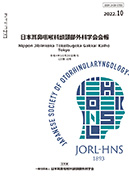Volume 125, Issue 10
Displaying 1-17 of 17 articles from this issue
- |<
- <
- 1
- >
- >|
Review article
-
Article type: review-article
2022 Volume 125 Issue 10 Pages 1431-1436
Published: October 20, 2022
Released on J-STAGE: November 05, 2022
Download PDF (1217K) -
Article type: review-article
2022 Volume 125 Issue 10 Pages 1437-1439
Published: October 20, 2022
Released on J-STAGE: November 05, 2022
Download PDF (347K) -
Article type: review-article
2022 Volume 125 Issue 10 Pages 1440-1445
Published: October 20, 2022
Released on J-STAGE: November 05, 2022
Download PDF (1885K) -
2022 Volume 125 Issue 10 Pages 1446-1448
Published: October 20, 2022
Released on J-STAGE: November 05, 2022
Download PDF (493K) -
Article type: review-article
2022 Volume 125 Issue 10 Pages 1449-1454
Published: October 20, 2022
Released on J-STAGE: November 05, 2022
Download PDF (1037K) -
Article type: review-article
2022 Volume 125 Issue 10 Pages 1455-1458
Published: October 22, 2022
Released on J-STAGE: November 05, 2022
Download PDF (511K) -
Article type: review-article
2022 Volume 125 Issue 10 Pages 1459-1463
Published: October 20, 2022
Released on J-STAGE: November 05, 2022
Download PDF (2178K)
Original article
-
Article type: Original article
2022 Volume 125 Issue 10 Pages 1464-1471
Published: October 20, 2022
Released on J-STAGE: November 05, 2022
Download PDF (675K) -
Article type: Original article
2022 Volume 125 Issue 10 Pages 1472-1479
Published: October 20, 2022
Released on J-STAGE: November 05, 2022
Download PDF (483K) -
Article type: Original article
2022 Volume 125 Issue 10 Pages 1480-1486
Published: October 20, 2022
Released on J-STAGE: November 05, 2022
Download PDF (2182K)
Final Lecture
-
2022 Volume 125 Issue 10 Pages 1487-1497
Published: October 20, 2022
Released on J-STAGE: November 05, 2022
Download PDF (962K)
Training lecture
-
2022 Volume 125 Issue 10 Pages 1500-1504
Published: October 20, 2022
Released on J-STAGE: November 05, 2022
Download PDF (776K)
Skill up lecture
-
2022 Volume 125 Issue 10 Pages 1505-1508
Published: October 20, 2022
Released on J-STAGE: November 05, 2022
Download PDF (511K) -
2022 Volume 125 Issue 10 Pages 1508-1511
Published: October 20, 2022
Released on J-STAGE: November 05, 2022
Download PDF (506K)
-
2022 Volume 125 Issue 10 Pages 1512-1513
Published: October 20, 2022
Released on J-STAGE: November 05, 2022
Download PDF (479K)
ANL Secondary Publication
-
2022 Volume 125 Issue 10 Pages 1514-1515
Published: October 20, 2022
Released on J-STAGE: November 05, 2022
Download PDF (353K) -
2022 Volume 125 Issue 10 Pages 1516-1517
Published: October 20, 2022
Released on J-STAGE: November 05, 2022
Download PDF (361K)
- |<
- <
- 1
- >
- >|
